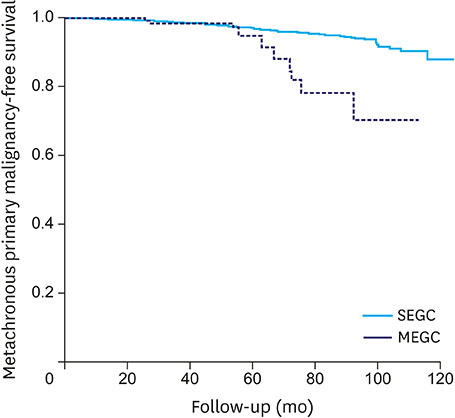J Gastric Cancer.
2017 Jun;17(2):154-161. 10.5230/jgc.2017.17.e19.
Multiple Primary Malignancies in Patients with Multiple Early Gastric Cancer
- Affiliations
-
- 1Department of Surgery, Chungbuk National University Hospital, Cheongju, Korea.
- 2Department of Surgery, Samsung Medical Center, Sungkyunkwan University School of Medicine, Seoul, Korea. tssohn@skku.edu
- KMID: 2383738
- DOI: http://doi.org/10.5230/jgc.2017.17.e19
Abstract
- PURPOSE
This study aimed to investigate the correlation between multiple early gastric cancer (MEGC) and multiple primary malignancies during the follow-up of patients with gastrectomy.
MATERIALS AND METHODS
The number of primary tumors detected in other organs after gastrectomy for early gastric cancer (EGC) has been increasing because of improved survival and surveillance programs. A total of 3,129 patients underwent radical gastrectomy for treatment of EGC at Samsung Medical Center from January 2000 to December 2005. Of these, 3,057 patients were selected and their medical records were retrospectively analyzed.
RESULTS
Among the 3,057 patients, 148 (4.8%) had MEGC, 84.5% were male, 57.4% were over 60 years old, 42.6% had a macroscopic type EGC IIb main lesion, and 68.9% had well-differentiated tumors with a significantly high incidence of MEGC. There were no differences between patients with solitary early gastric cancer (SEGC) and those with MEGC with regard to overall survival or recurrence-free survival, but MEGC was an independent risk factor for metachronous primary malignancies in other organs (P=0.004, hazard ratio [HR]=2.444).
CONCLUSIONS
MEGC is not a risk factor for poor prognosis after curative gastrectomy, but it is a risk factor for metachronous primary malignancies in other organs during postoperative follow-up; therefore, careful surveillance is needed.
MeSH Terms
Figure
Reference
-
1. Peng J, Wang Y. Epidemiology, pathology and clinical management of multiple gastric cancers: a mini-review. Surg Oncol. 2010; 19:e110–e114.2. Moertel CG, Bargen JA, Soule EH. Multiple gastric cancers; review of the literature and study of 42 cases. Gastroenterology. 1957; 32:1095–1103.3. Noh SH, Chung WY, Min JS. Clinical study of synchronous multiple early gastric cancer. J Korean Surg Soc. 1995; 49:328–334.4. Park SS, Ryu KW, Song TJ, Mok YJ, Kim CS, Kim SJ. Multiple early gastric cancer. J Korean Gastric Cancer Assoc. 2001; 1:150–154.5. Takeshita K, Tani M, Honda T, Saeki I, Kando F, Saito N, et al. Treatment of primary multiple early gastric cancer: from the viewpoint of clinicopathologic features. World J Surg. 1997; 21:832–836.6. Honmyo U, Misumi A, Murakami A, Haga Y, Akagi M. Clinicopathological analysis of synchronous multiple gastric carcinoma. Eur J Surg Oncol. 1989; 15:316–321.7. Kitamura K, Yamaguchi T, Okamoto K, Otsuji E, Taniguchi H, Hagiwara A, et al. Clinicopathologic features of synchronous multifocal early gastric cancers. Anticancer Res. 1997; 17:643–646.8. Ahn YJ, Oh SJ, Song JW, Kang WH, Hyung WJ, Choi SH, et al. The clinicopathologic features and prognosis of multiple early gastric cancer. J Korean Gastric Cancer Assoc. 2008; 8:198–202.9. Shah BK, Khanal A, Hewett Y. Second primary malignancies in adults with gastric cancer: a US population-based study. Front Oncol. 2016; 6:82.10. Chung KY, Mukhopadhyay T, Kim J, Casson A, Ro JY, Goepfert H, et al. Discordant p53 gene mutations in primary head and neck cancers and corresponding second primary cancers of the upper aerodigestive tract. Cancer Res. 1993; 53:1676–1683.11. Sozzi G, Miozzo M, Pastorino U, Pilotti S, Donghi R, Giarola M, et al. Genetic evidence for an independent origin of multiple preneoplastic and neoplastic lung lesions. Cancer Res. 1995; 55:135–140.12. Luciani A, Balducci L. Multiple primary malignancies. Semin Oncol. 2004; 31:264–273.13. Japanese Gastric Cancer Association. Japanese classification of gastric carcinoma: 2nd English edition. Gastric Cancer. 1998; 1:10–24.14. Warren S, Gates O. Multiple primary malignant tumors. A survey of the literature and statistical study. Am J Cancer. 1932; 16:1358–1414.15. Moertel CG. Multiple primary malignant neoplasms: historical perspectives. Cancer. 1977; 40:1786–1792.16. Kang GH, Kim CJ, Kim WH, Kang YK, Kim HO, Kim YI. Genetic evidence for the multicentric origin of synchronous multiple gastric carcinoma. Lab Invest. 1997; 76:407–417.17. Mitsudomi T, Watanabe A, Matsusaka T, Fujinaga Y, Fuchigami T, Iwashita A. A clinicopathological study of synchronous multiple gastric cancer. Br J Surg. 1989; 76:237–240.18. Kosaka T, Miwa K, Yonemura Y, Urade M, Ishida T, Takegawa S, et al. A clinicopathologic study on multiple gastric cancers with special reference to distal gastrectomy. Cancer. 1990; 65:2602–2605.19. Esaki Y, Hirokawa K, Yamashiro M. Multiple gastric cancers in the aged with special reference to intramucosal cancers. Cancer. 1987; 59:560–565.20. Dinis-Ribeiro M, Lomba-Viana H, Silva R, Moreira-Dias L, Lomba-Viana R. Associated primary tumors in patients with gastric cancer. J Clin Gastroenterol. 2002; 34:533–535.21. Ryu DD, Um JW, Son GS, Cho MY, Song TJ, Kim CS, et al. Multiple primary malignant tumors in patients with gastric cancer. J Korean Gastric Cancer Assoc. 2003; 3:139–144.22. Watanabe S, Kodama T, Shimosato Y, Arimoto H, Sugimura T, Suemasu K, et al. Multiple primary cancers in 5,456 autopsy cases in the National Cancer Center of Japan. J Natl Cancer Inst. 1984; 72:1021–1027.
- Full Text Links
- Actions
-
Cited
- CITED
-
- Close
- Share
- Similar articles
-
- Multiple Primary Cancers Including Colorectal Cancer
- A Case of Multiple Early Gastric Cancer
- A Case of Early Gastric Cancer Associated with Small Cell Lung Cancer
- A Case of Synchronous Double Primary Cancer: Gastric Carcinoid and Early Gastric Cancer
- Study of Combined Multiple Primary Cancer in Gastric Cancer Patients


